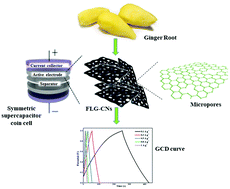Scalable, large-area synthesis of heteroatom-doped few-layer graphene-like microporous carbon nanosheets from biomass for high-capacitance supercapacitors
Abstract
High-capacitance electrochemical supercapacitors are promising devices due to their long-term stability and simple device construction. Unlike available reports on biomass-derived carbon as supercapacitor electrodes, in this paper, we report novel few-layer graphene-like microporous carbon nanosheets obtained from a single biomass precursor, which yield very high specific capacitance. A simple, ultra-low cost, one-step activation-free approach yields few-layer graphene-like microporous carbon nanosheets in the presence of heteroatoms by using ginger root as a biomass precursor. Suitable heteroatom content combined with porous graphene-like carbon nanosheet structure enhances the specific capacitance. The as-prepared carbon nanosheets from ginger roots possessing few-layer graphene-like structures are confirmed by X-ray diffraction and transmission electron microscopy, and the presence of few heteroatoms is confirmed by energy dispersive spectroscopy. The electrochemical measurements reveal that the ginger root-derived carbon electrode exhibits very high specific capacitance of 390 F g−1 at 1 A g−1 of current density. The ginger-derived carbon electrode also has 93.3% capacitance retention until 3500 charge/discharge cycles. This approach indicates great potential to achieve sustainable, low-cost, simple and large-scale production of renewable biomass-derived carbon materials for efficient energy storage applications in the future.



 Please wait while we load your content...
Please wait while we load your content...